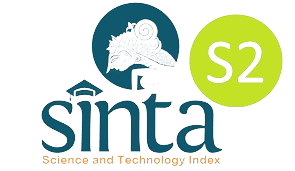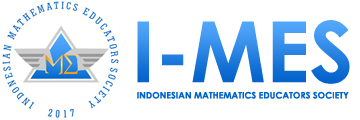Bahan Ajar Transformasi Geometri Berbasis Discovery Learning melalui Pendekatan Etnomatematika
DOI:
https://doi.org/10.29408/jel.v4i2.705Keywords:
teaching materials, discovery learning, ethnomathematics, geometry transformationAbstract
The purpose of this research is to produce discovery learning based materials through ethnomathematics approaches on geometry transformation materials (valid, practical, and effective) and according to the needs of students. The type of this research is Research and Development (R & D) by using Plomp Model which consists of five stages: prelimenary investigation; realization/construction; test, evaluation and revision; dan implementation. The instruments were used the form of validation questionnaire, student response sheet, observation sheet of teaching materials implementation, and achievement test. Based on the research, the result of the validation of experts with the percentage of 83% (very valid), 84.50% (very practical), and the effectiveness of 85.71% (high). Based on this development research the advantages of teaching materials are material materials related to the ethnomathematics of Batik Lampung pattern on the application of the concept of geometry transformation. The weakness of teaching materials developed is that the material discussion is limited to the type of geometry transformation and its effective test is only based on the KKM. Further product development, teaching materials can cover the entire material of geometry transformation with other Lampung culture ethnomathematics studies and effectiveness tests are thoroughly tested from learning outcomes, activities and learners' abilities.References
Acharya, B. R. (2017). Factors affecting difficulties in learning mathematics by mathematics learners. International Journal of Elementary Education, 6, 8-15. Crossref.
Astuti. S. (2017). Pengembangan bahan ajar matematika dengan model Discovery Learning untuk meningkatkan kemampuan pemahaman prinsip-prinsip matematika dan kemampuan penalaran logis siswa di SMAN 1 Jarai Kabupaten Lahat. Edu-Mat Jurnal Pendidikan Matematika, 5, 71-75.
Balım, A., G. (2009). The effects of discovery learning on students’ success and inquiry learning skills. Eurasian Journal of Educational Research, 35, 1-20.
Fujiati, I., & Mastur, Z. (2014). Keefektifan model pogil berbantuan alat peraga berbasis etnomatematika terhadap kemampuan komunikasi matematis. Unnes Journa of Mathematics Education, 3, 174-180.
Hasan, A., & Fraser, B. J. (2015). Effectiveness of teaching strategies for engaging adults who experienced childhood difficulties in learning mathematics. Learning Environments Research,18, 1-13. Crossref.
Kistian, A., Armanto, D., & Sudrajat, A. (2017). The effect of discovery learning method on the math learning of the V SDN 18 Students of Banda Aceh, Indonesia. British Journal of Education, 5, 1-11.
Kurniawati, F. E. (2015). Pengembangan bahan ajar aqidah ahklak di Madrasah Ibtidaiyah. Jurnal Penelitian Dinas Pendidikan Kabupaten Sragen, 9, 367-388. Crossref.
Mahendra, I. W. E. (2017). Project based learning bermuatan etnomatematika dalam pembelajaran matematika. Jurnal Pendidikan Matematika, 6, 106-114.
Peraturan Menteri Pendidikan dan Kebudayaan Republik Indonesia Nomor 87 tentang Program Pendidikan Profesi Guru Pra Jabatan. (2013). Jakarta: Kemdikbud.
Plomp, T. & Nieveen, N. (2010). Educational design research: An introduction. In T. Plomp., & N. Nieveen (Ed.). An introduction to educational design research. Enschede: SLO•Netherlands Institute for Curriculum Development.
Putri, L. I. (2017). Eksplorasi etnomatematika kesenian rebana sebagai sumber belajar matematika pada jenjang MI. Journal Ilmiah Pendidikan Dasar, 4, 21-30.
Rahman, R., & Maarif, S. (2014). Pengaruh penggunaan metode discovery terhadap kemampuan analogi matematis siswa SMK Al-Ikhsan Pamarican Kabupaten Ciamis Jawa Barat. Infinity, 3, 33-58. Crossref.
Rochmad. (2012). Desain model pengembangan perangkat pembelajaran matematika. Kreano, 3, 59-72.
Rosa, M., & Orey, D. C. (2007). Cultural assertions and challenges towards pedagogical action of an ethnomathematics program. For the Learning of Mathematics, 27, 10-16.
Rosa, M., & Orey, D. C. (2016). State of the art in ethnomathematics. In M. Rosa et al (Eds.), Current and future perspectives of ethnomathematics as a program (pp.11-38). New York: Springer. Crossref.
Samo, D. D. (2017). Kemampuan pemecahan masalah mahasiswa tahun pertama pada masalah geometri konteks budaya. Jurnal Riset Pendidikan Matematika, 4, 141-152. Crossref.
Sanchez, C. H., & Albis, V. (2013). Ethnomathematics, In Runehov, A.L.C., Oviedo, L., and Azari, N.P (Ed.), Encyclopedia of sciences and religions. Springer: New York. Crossref.
Sherman, H. J., Richardson, L.I., & Yard, G.J. (2014). Why do students struggle with mathematics. Diambil dari https://www.education.com/reference/article/why-students-struggle-mathematics/.
Siniguian, M. T. (2017). Students difficulty in solving mathematical problems. International Journal of Advanced Research in Engineering and Applied Sciences, 6, 1-12.
Sirate, F. S. (2012). Implementasi etnomatematika dalam pembelajaran matematika pada jenjang pendidikan sekolah dasar. Lentera Pendidikan, 15, 41-54. Crossref.
Suryadinata, N. (2015). Pengembangan perangkat pembelajaran strategi Quick On The Draw dengan masalah Open Ended untuk meningkatkan kemampuan berpikir kreatif materi prisma dan limas. Aksioma: Jurnal Program Studi Pendidikan Matematika, 4, 9-21. Crossref.
Wahyuni, A., dkk. (2013). Peran etnomatematika dalam membangun karakter bangsa. Makalah dipresentasikan pada Seminar Nasional Matematika dan Pendidikan Matematika FMIPA UNY. Yogyakarta: Universitas Negeri Yogyakarta.
Yusta, N., dkk. (2016). Impact of instructional resources on mathematics performance of learners with dyscalculia in integrated primary schools, arusha city, tanzania. Journal of Education and Practice, 7, 12-18.
Downloads
Additional Files
Published
How to Cite
Issue
Section
License
Authors who publish with the Jurnal Elemen agree to the following terms:
- Authors retain copyright and grant the journal right of first publication with the work simultaneously licensed under Creative Commons Attribution-ShareAlike 4.0 International License (CC BY-SA 4.0).
- Authors are able to enter into separate, additional contractual arrangements for the distribution of the journal's published version of the work (e.g., post it to an institutional repository or publish it in a book), with an acknowledgment of its initial publication in this journal.
- Authors are permitted and encouraged to post their work online (e.g., in institutional repositories or on their website) prior to and during the submission process, as it can lead to productive exchanges, as well as earlier and greater citation of published work.
Jurnal Elemen is licensed under a Creative Commons Attribution-ShareAlike 4.0 International License





